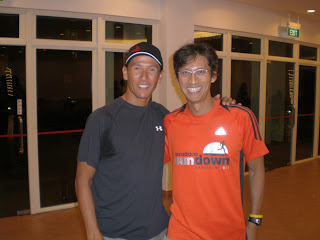I managed 193K after being battered by sidewinds and headwinds, the dreaded heat, and after I witnessed a fallen cyclist; I think she was bleeding at her chin. Fortunately, her friends were with her and tended to her, sitting her up and assuring her; there was also a suspect truck adjacent to them. It was nearly one o’clock in the afternoon and I decided to head back home due to the insistent heat. My quads were noticeably tight as I did 5 loops worth of gentle slopes; in fact, this was my longest ride so far. My longest one recently was about 70K. I had spent the past six months on developing my marathon legs. After Berlin, I did a 30K and 15K race, and decided that I better get my posterior on the saddle. The past fortnight of evening fast 30-60K rides seem to have engaged my latent riding muscles. Kevin of Perth wrote that the 7K I missed were marginal, and I agree. Today’s ride is 110-120K more than I have done for a while. It was a pity I could have enjoyed more company: I was riding shotgun before I went solo.
*****
Is Macca giving 2011 Kona Ironman the flick? It was reported that this looks likely as he just won his second Ironman World Championships title three years apart in the seventh fastest time ever. Next to fellow Australian, Craig Alexander (twice world champion), he may be the oldest competitor to defend his title, which will be challenging in the face of new and hungry professional triathletes. Macca blew his chance to defend his title in 2008 when he experienced mechanical issues with his bike. It must be sweet to savour success twice (at Kona) in one’s career.
In conversations with friends, it seems that most prefer Crowie’s introverted personality. The extraverted, chatty, and smack-talking Macca may be more direct and honest, however he seems to back up his opinions with performance. It has been four times in a row, since 2007 where Australians have dominated in the Ironman World Championships reign. Rinnie joins them as the female Australian pro to win Kona this year. Mirinda Carfrae assumes the title after Chrissy Wellington, and before that Australian Olympian, Michellie Jones. In Aussie-speak, a braggart is a ‘tall poppycock’. Personally, I like some pre-race excitement, like the Ali-Frazier press conferences in the 1970’s, and also the WWE harangues. Sometimes, the bark is louder than the bite.







